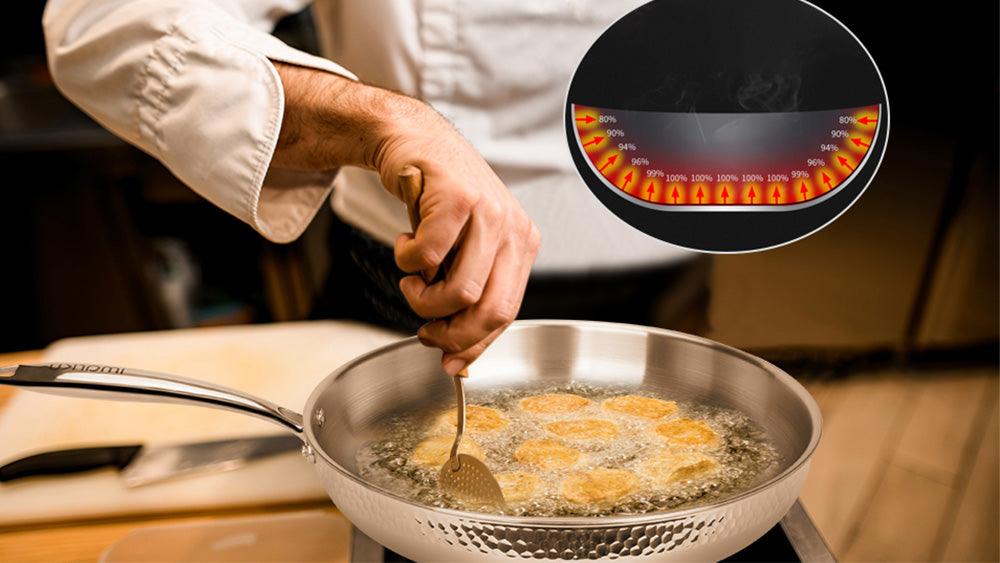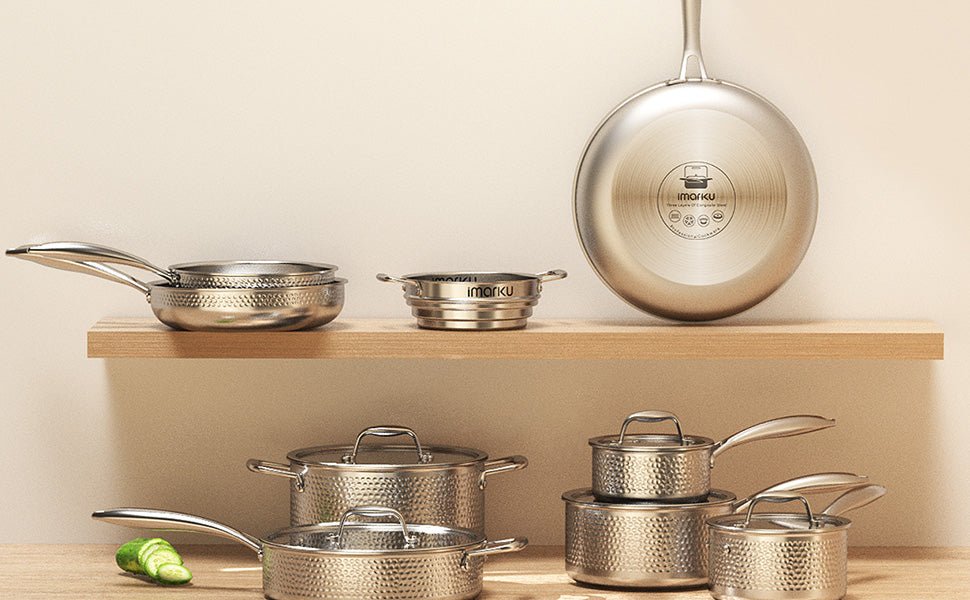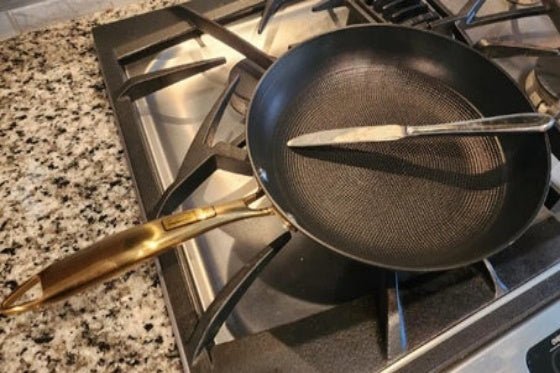TABLE OF CONTENTS
Cooking with stainless steel might sound fun until you cook just one meal and realize you actually have no idea. From burned to poorly made meals, you will have to learn on the job.
Fortunately for you, we have some awesome tips to share with you, to help you make the most out of your cookware set. Let’s dig in!
Is it safe to cook with stainless steel?
Yes, it is generally safe to cook with stainless steel. Stainless steel cookware is made from steel and doesn’t rust or stain over time. Some of them are undeniably indestructible due to the multi-ply manufacturing processes they undergo. So, with the right maintenance, your set can last you decades and still survive to be passed on through generations.
Furthermore, due to their multi-ply nature, these cookware offer impressive cooking ability. They easily absorb and evenly distribute heat, ensuring your meals are properly cooked.
That’s not all, the stainless steel set’s non-porous smooth surface is easy to clean. They are hard enough to withstand regular scrubbing for stain and debris removal. However, avoid using rough sponges as they leave scratches behind. Besides, they’re robust enough to allow soaking and controlled dishwasher cleaning without worrying about unnecessary damage.
Additionally, it’s easy to maintain stainless steel. They have no special cleaning or maintenance requirements. All you need is to use the right solution to help lift stubborn scorches when necessary. Besides that, you will only need to clean your stainless steel cookware with soap, dry and properly store it to serve you a lifetime.
Plus, these types of cookware do not react to acidic foods. So, you can try out your tomato sauce and fish dishes recipes without risking chemicals draining into your food. They are also not cumbersome to use in your cooking, maneuver or store in your small space.
Although this cookware can be expensive, they’re generally affordable for most people. And with the decent quality they offer, including being recyclable, they’re worth every penny.
Tips for Cooking with Stainless Steel
How to Prevent Food from Sticking on your Stainless Steel
The main reason why food sticks to stainless steel cookware are heat. It could be too much or too little heat, and it is frustrating. But you can avoid this by properly preparing your pan.
First, ensure you preheat your pan well by placing it over medium heat for around 2-3 minutes. You can add some oil before the pan heats or when it gets hot. However, it’s best to add oil when the pan is already hot for the best results. This will prevent the oil from getting hot before the pan, giving you an illusion of a hot pan.
Consequently, you can conduct the TSS test. This is simply using a drop of water to test whether your pan is ready for use or not. If the pan is ready, the water drop should make a “TSS” sound before multiplying into several droplets and eventually evaporating. Always start your pan on medium heat, then make necessary adjustments from there.
Also, consider using dry food as the water in wet food combats the heat bringing the oil temperature down. But, since sometimes you have to use recently washed foods, such as vegetables, consider patting them down with a paper towel to drain the excess moisture. Always ensure cold food is brought down to room temperature before cooking in stainless.
However, even with all these measures, some foods just stick when cooking with stainless cookware, and there is little you can do about it. For example, omelets, and pancakes rarely come off cleanly. So, it’s best to know when to lose some battles and consider using non-stick for such foods. Here are the differences in cooking tips with stainless steel and nonstick cookware.
Season your Stainless Steel to create a non-stick layer by heating it over medium heat for around 2 minutes. Then add some oil to form a layer, and heat it for about 5 minutes. Afterwards, remove the pan from the heat and let it completely cool before discarding the oil. Now wipe it with a paper towel and enjoy cooking with your newly created non-stick pan surface!
Stainless Steel Oven Use
Before using your stainless cookware in the oven, ensure to read the manufacturer manual to see if it’s oven-safe. If it is the case for most stainless, go ahead and experiment with some oven recipes, such as pork chops and steaks.
Stainless Steel Care Mistakes to Avoid
As mentioned earlier, stainless steel can last you a lifetime with proper care. Therefore, avoiding the following mistakes will keep your cookware set looking and feeling as good as new every time you use them.
Using Steel Wool
Steel wool might seem like the quickest way to remove stains from your cookware, but together with any kind of rough sponges, they will leave scratches on your stainless. Besides, some manufacturer warranty will not cater for such damages. Therefore always use soft sponges. While on it, use the right cleaner, especially if regular soap and water aren’t working for you.
Regularly using the Dishwasher
While dishwashers are good at offering convenience and efficiency, you shouldn’t entirely rely on them. Due to their high temperatures and prolonged circles, they might end up damaging your cookware’s surfaces, leaving some stubborn spots, especially when washed with plastics. Also, long circles can damage the handles. Therefore, find the right balance between hand-washing and using a dishwasher.
Cleaning Stainless while Hot
Although it’s easy to clean off the dirt from hot cookware, exposing them to cold water does more harm than good. The sudden change of temperatures can cause them to crack or deform. It’s also not safe for you since the hot steam can burn your hands.
Not Removing Calcium Build-ups
Calcium build-ups appear faster or slowly on your stainless, depending on the hardiness of your water. They’re tiny chalky white spots that can cause bacteria growth if ignored. To remove then, add ¼ cup of vinegar to a cup of water and boil in your cookware. Afterwards, remove from heat, let it cool, wash, dry and store your cookware.
Not Hand Drying
The best way to remove those unattractive water spots from your stainless steel is by hand drying them using a kitchen towel after washing.
Overheating
If you overheat your stainless steel cookware, you will begin to notice rainbow stains around its edges. To clear this, scrub it with vinegar.

























Leave a comment
All comments are moderated before being published.
This site is protected by hCaptcha and the hCaptcha Privacy Policy and Terms of Service apply.